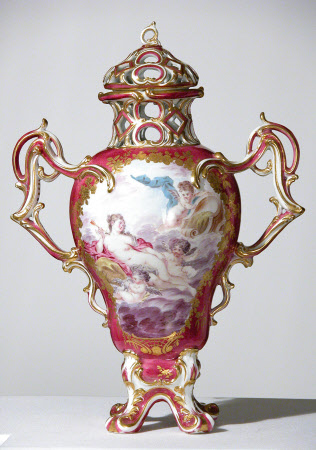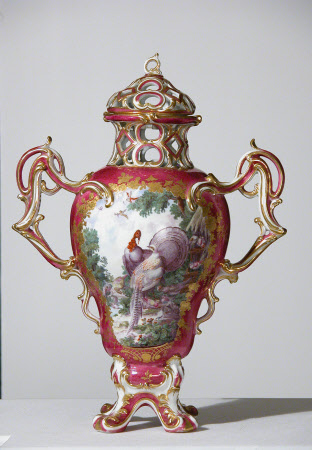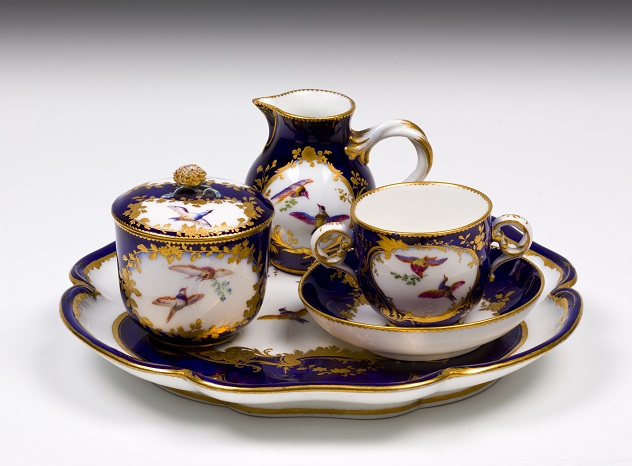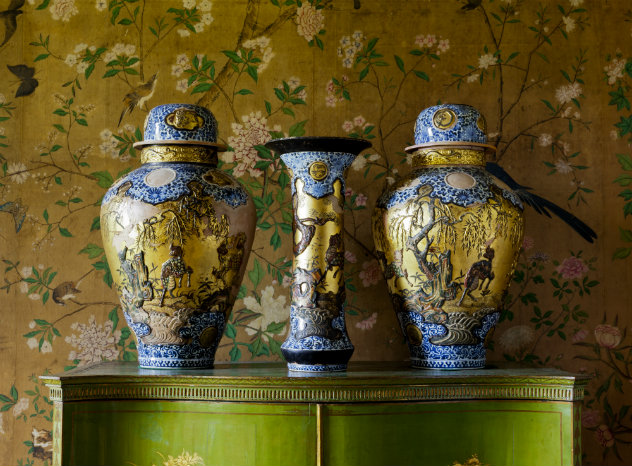Vase cover
Melchior d'Hondecoeter (Utrecht 1636 - Amsterdam 1695)
Category
Ceramics
Date
1765
Materials
Porcelain
Measurements
6.5 cm (Height); 8.5 cm (Diameter)
Place of origin
Chelsea
Order this imageCollection
Upton House, Warwickshire
NT 446369.4
Summary
Cover to a jar, from a seven-piece garniture of pot-pourri jars (‘perfume pots’), soft-paste porcelain, inverted pear-shaped on four scroll feet with two pierced scroll-handles, pierced neck and cover, the reserved panels on a crimson (or claret) coloured ground with foliate tooled gilding painted in polychrome enamels with a languid Venus, goddess of love, identified by her chariot, who holds Cupid’s arrow, surrounded by three amorini, one rests by her side, while another readies her chariot and a third plays with billing doves, the reverse with birds after the Dutch artist Melchior de Hondecoeter (1636-95), maker's mark a gold anchor mark; Chelsea, London, England, circa 1763-4. The subject of Venus disarming Cupid derives from ‘Ovid's Metamorphoses’. It depicts Cupid's punishment for playfully scratching his mother with his love-inflicting arrow, however, the goddess of love has already fallen for a mortal, Adonis, who will die after their first and only encounter (see 446369.11-12). No direct source for the image has been found, rather it appears to be partially based on a French engraving, L’Amour Désarmé by Etienne Fessard (1714-77) after François Boucher (1703-70), dedicated to 'Madame de Pompadour, Dame du Palais de La Reine' and published according to the ‘Mercure de France’ in April 1761. The Chelsea painter apparently used this print to create two scenes on two of the jars in the garniture: here, Venus plays with Cupid’s arrow, which is missing in the scene on 446369.13-14, which faithfully copies the figure of Venus. The original painting, ‘L’Amour Désarmé’, was commissioned by Louis XV to decorate the ‘appartement des bains’ at the royal Château de Choisy in 1751. There is an example of the engraving in the Fitzwilliam Museum, Cambridge, acc. no. 34.17-84. A pot-pourri jar of the same form and ground colour, but with a bucolic landscape, is in the V&A Museum, London, 830-1882. (Ferguson, 2014) The depictions of farmyard fowl and pheasants in formal landscapes, including peacocks and turkeys in the 17th-century manner of Melchior de Hondecoeter (1636-95) or Francis Barlow (1626-1704), ‘Multae et diversae avium species’, London, 1650-55, were possibly also based on engravings by Joseph Sympson (1710-50) after paintings by Marmaduke Craddock (c.1660-1716), published in 1741-3. Provenance: 'Said to have been for George III as a present to Lady Cope on her marriage in 1767 and subsequently in the possesion of Lord Dudley, hence their title 'The Dudley Vases''.
Makers and roles
Melchior d'Hondecoeter (Utrecht 1636 - Amsterdam 1695), painter



